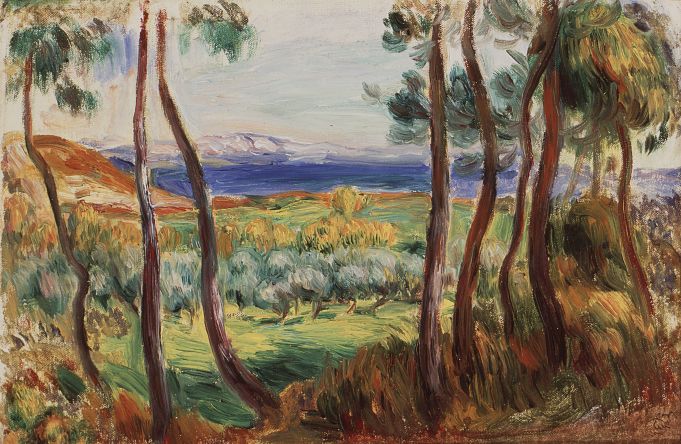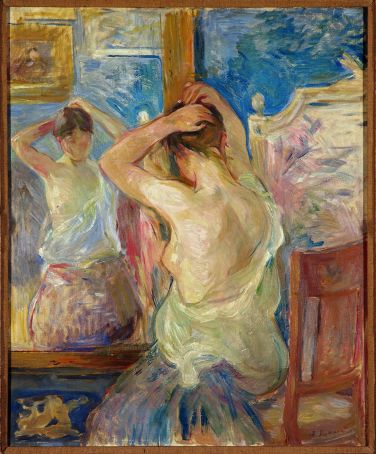Rome's newly-restored Palazzo Bonaparte hosts an exhibition of seldom seen Impressionist paintings.
There is something almost private (rather than "secret") about this exhibition, titled Impressionisti segreti. It is a small and intimate show. The paintings come from minor and private collections rather than state museums. Furthermore, the restoration of this small and perfectly proportioned Roman palace has been so beautifully achieved that when you walk into the first floor rooms you feel that this is how it might have been when Letizia Ramolino Bonaparte and her brother lived there from soon after Napoleon's death until her own demise in 1836.
Of course the paintings now hanging in the six or seven small rooms in Palazzo Bonaparte would have seemed outrageous to Napoleon's mother; none of the usual grandiose, historical scenes, battle victories, classical myths or pompous political portraits. Even the view over Piazza Venezia would have been different. Instead of the massive Vittorio Emanuele monument there would have been the Ara Coeli church that now nestles behind it and a clutter of houses and winding streets leading off to the grass-covered ruins of the Forum and Colosseum.
Changing views
If it is difficult to remember how much the view from the famous green balcony has changed, it is no less difficult to appreciate how startling these Impressionist paintings would have seemed when they first appeared in Paris in the 1860s. Outdoor, real-life and colourful scenes, so common now, were unheard of then. Men working in the fields, instead of soldiers marching to war, children playing with their toys and reading books instead of putti or classical gods fluttering overhead. Trees, rivers, fields and very ordinary farm houses, even industrial buildings, who would have wanted these? The new subject matter, as well as the new ideas about mixing colour and putting paint on canvas, led inevitably to a whole range of new buyers, new collectors, new dealers, new galleries, all outside the old academic, salon and patronage networks.
The 51 paintings in this exhibition are divided into three themes: landscapes, portraits and Paris life. There is an informality about them, which is precisely what made them so shocking when they first hit Paris. Most of them feel as though they were painted for the sheer pleasure of painting rather than with an eye to a commission or possible patron.
There are paintings of friends and of friends' children. Renoir paints the two daughters of Martial Caillebotte (the younger brother of painter Gustave) surrounded by children's books. Achille Laugé paints his wife in Dinanzi alla Finestra looking down at an object on a table by the window; both figures in this austere painting are engrossed in household chores. Manet paints Berthe Morisot with a veil, a seemingly unfinished version of several other portraits he painted of his sister-in-law. In Davanti alla Psiche, Morisot paints the back of a half-dressed woman, pinning up her hair as she looks into a mirror. Both the lone woman from the back (and her featureless face in the mirror) coupled with the intimacy of her task were new departures.
Thanks to sensitive hanging there is an equally expressive back in the same room. In Gustave Caillebotte's Interno, donna alla finestra, the back of a woman dressed in black dominates the composition as she gazes out of the window at a chunky building opposite, where a shadowy figure stands at a window. Her husband, seated and reading a newspaper, seems indifferent, even bored, by her presence. A tense anguish hangs over the narrative.
Italian Impressionism
Another interesting juxtaposition is that of Renoir's Testa di Donna next to Sul Divano [see article's cover image] by Federico Zandomeneghi, the only Italian in the show. Renoir's young woman has a wearisome look in her eyes and her mouth is parted but not in a smile. As the catalogue suggests, this could have been a study for Renoir's Le Bagnanti in Philadelphia (rather than the one in Paris) but the face lacks the feeling in Zandomeneghi's work next to it. Here the expression on the face of the younger woman in profile is intriguing. Is she listening to the older woman – perhaps her mother whom we see only from the back – with interest, curiosity, indecision, perhaps even scepticism?

Instead of the usual fare of Monet water lilies, cathedrals or watery views of Venice, this exhibition shows the lesser known Meli in fiori in riva all'acqua, a gnarled and crooked tree trunk with staccato blobs of cream paint for the apple blossoms. It is as powerful as Monet's water lilies are serene, and although it is only small (73 x 60 cm) it has such a commanding presence that it seems much larger. Monet's Isle of Nettles is also somewhat unsettling, looming large as it does in its violet-blue mist on the opposite bank of the Seine.
Two portraits by Renoir remind us of what painters know but often resent: that portrait commissions are always a sure way to pay off debts and repay favours. Madame Joseph Durand-Ruel presides over the room where her portrait hangs. She was the daughter-in-law of Paul Durand-Ruel, Renoir's friend and the most successful of all Impressionist collectors and gallerists. She may be sitting comfortably in a day dress rather than evening finery, but there is nothing ordinary about her splendid diamond and emerald ring or the floral decoration in the background. This portrait is hung next to an earlier one by Renoir, of the wife of another of the Impressionist patron-collector-gallery owners, Josse Bernheim-Dauberville, an early version of the more famous one of the wife of the other brother, Gaston, which hangs in the Musée d'Orsay.
Some of the landscapes in this exhibition seem almost routine today: pretty sea views, river scenes and rolling landscapes. Two vertical scenes by Pissarro stand out. One, I Tetti della Vecchia Rouen, Sole, is a scene of the roof-tops of the Normandy city, probably a winter scene, judging by the light. The other is of a line of spindly trees just beginning to turn to autumn colouring. I grandi faggi a Varengeville was one of eight Pissarro painted near Dieppe in 1899, most of which were bought by Durand-Ruel, and is in the Mexican Perez Simon collection, the largest single named lender of paintings to this show.

One landscape by Renoir, Pini nel Dintorno a Cagnes, is particularly intriguing. It is a late work from 1910, painted a few years after Renoir bought a property in Cagnes sur Mer, close to Nice. In addition to the strong Mediterranean colouring there are echoes of Van Gogh in those undulating olives in the middle distance. In Gaugin's Pescatori Bretoni, the languid river fishermen seem a far cry from the exotic figures of his later Tahiti period. Caillebotte's La Piana di Gennevilliers, which stretches to the far horizon, is cut into mustard-green and rose-brown rectangles, set on the diagonal, crossed horizontally in the foreground by the Seine and an improbably small steamer. Take a leap of the imagination and you are into Abstraction.
Women Impressionists
Sadly, the women Impressionists, other than Morisot, do not have their due share in this exhibition. There is only one painting by Manet's pupil Eva Gonzales, Indolenza, of a rather wistful young girl (Eva's younger sister Jeanne) looking into the distance. But there is no work by that other great French Impressionist, Marie Bracquemond, or by the American Mary Cassatt.
Cassatt was born in Pennsylvania, studied at the highly-regarded Philadelphia Academy of Fine Arts and subsequently went to live in Paris. Her friendship there with the collector Paul Durant-Ruel, combined with what must have been a flair for business, was responsible for launching the success of the Impressionists in the USA, where new money was chasing European culture. What a scoop it would have been the viewers to see her sulky and undignified Little Girl in a Blue Armchair (in which Degas had a hand) together with Morisot's Girl with a Doll (dressed in black, no less) and Renoir's painting of the two beautifully behaved daughters of Martial Cailleboit in this jewel of an exhibition.
Review by Mary Wilsey
The exhibition is open until 6 March. It is curated by Marianne Mathieu, the artistic director of the Monet Marmottan Museum in Paris, who also curated the successful Monet show in Rome in 2017-2018, and by Claire Durand-Ruel, expert on Pissarro and a descendant of collector Paul Durand-Ruel. There are also works by Henri-Edmond Cross, Armand Guillaumin, Paul Signac, Alfred Sisley and Theo van Rysselberghe. Palazzo Bonaparte is owned by Italy's insurance giant Generali Italia and the exhibition is organised by Arthemisia. For visiting details see website.
General Info
View on Map
Secret Impressionists in Rome: exhibition review
Piazza Venezia, 5, 00186 Roma RM, Italy


















